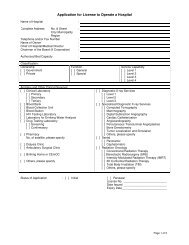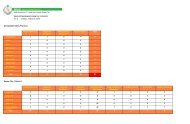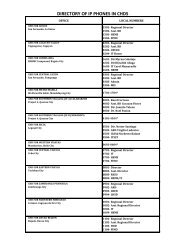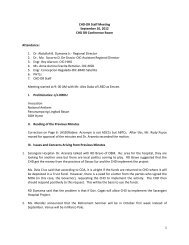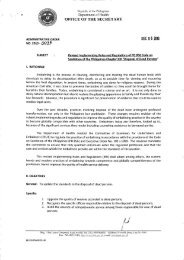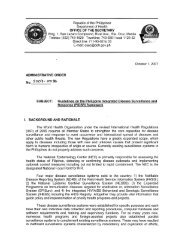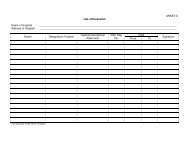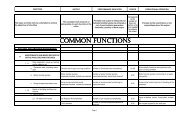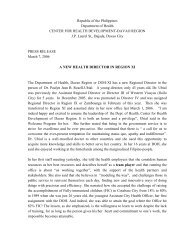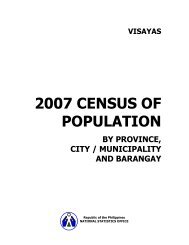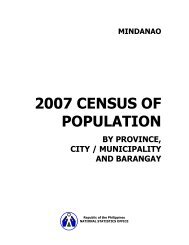Interim Guidelines on Surveillance of HFMD - CHD-Davao Region
Interim Guidelines on Surveillance of HFMD - CHD-Davao Region
Interim Guidelines on Surveillance of HFMD - CHD-Davao Region
You also want an ePaper? Increase the reach of your titles
YUMPU automatically turns print PDFs into web optimized ePapers that Google loves.
Implementing <str<strong>on</strong>g>Guidelines</str<strong>on</strong>g>The surveillance <strong>of</strong> <strong>HFMD</strong> and Severe Enteroviral Disease under the PIDSR will beimplemented with the supervisi<strong>on</strong> <strong>of</strong> the NEC. However, in order to enhance the sensitivity <strong>of</strong>the system to detect early cases <strong>of</strong> <strong>HFMD</strong> and Severe Enteroviral Disease or signs <strong>of</strong> humanto-humantransmissi<strong>on</strong>, the following activities should be simultaneously performed:Core <strong>Surveillance</strong> Activities1. Case Detecti<strong>on</strong>, Notificati<strong>on</strong>, and Reportinga. The NEC, based <strong>on</strong> current WHO guidelines and expert c<strong>on</strong>sensus, shall developstandard case definiti<strong>on</strong> for <strong>HFMD</strong> and Severe Enteroviral Disease.b. Disease surveillance coordinators (DSCs) shall report cases <strong>of</strong> unexplained acutefebrile illness with papulovesicular and maculopapular rash am<strong>on</strong>g health workerswho provide care for the patients.c. Disease surveillance coordinators shall report changes noted in the resp<strong>on</strong>se totreatment or in the treatment outcome for those with severe signs and symptoms.d. All reports and rumors <strong>of</strong> <strong>HFMD</strong> and Severe Enteroviral Disease must be reported tothe RESU, ESR and NEC for verificati<strong>on</strong>.e. Immediate reporting (within 24 hours) <strong>of</strong> <strong>HFMD</strong> and Severe Enteroviral Diseasecases under PIDSR shall be pursued. All epidemiology and surveillance units (ESU)are required to make weekly zero reporting even if no cases are seen during theweek.f. Reporting <strong>of</strong> <strong>HFMD</strong> and Severe Enteroviral Disease shall follow the described flow<strong>of</strong> notificati<strong>on</strong> for immediate notifiable disease in PIDSR (Annex A).2.Case Investigati<strong>on</strong>a. The case definiti<strong>on</strong> for suspected <strong>HFMD</strong> and Severe Enteroviral Disease are thefollowing:Suspected case <strong>of</strong> <strong>HFMD</strong>: Any individual, regardless <strong>of</strong> age, who develop acute febrileillness with papulovesicular or maculopapular rash <strong>on</strong> palms and soles, with or withoutvesicular lesi<strong>on</strong>/ulcers in the mouth.Probable case <strong>of</strong> <strong>HFMD</strong>: A suspected case that has not been c<strong>on</strong>firmed by a laboratory, but isgeographically (schools,community,etc.) and temporally (within 12 weeks) related to alaboratory-c<strong>on</strong>firmed case.C<strong>on</strong>firmed case <strong>of</strong> <strong>HFMD</strong>: A suspected case with positive laboratory result for HumanEnteroviruses that cause <strong>HFMD</strong>.Suspected case <strong>of</strong> Severe Enteroviral Disease: Any child less than ten (10) years <strong>of</strong> age withfever plus any severe signs and symptoms referable to central nervous systeminvolvement, aut<strong>on</strong>omic nervous system dysregulati<strong>on</strong> or cardiopulm<strong>on</strong>ary failure; or2
Actual collecti<strong>on</strong> <strong>of</strong> specimens shall be d<strong>on</strong>e <strong>on</strong>ly by trained disease surveillancecoordinators.5. Support to <strong>Surveillance</strong>a. Administrative, logistics or supply <strong>of</strong>ficers shall ensure the availability <strong>of</strong> appropriatePPE aside from transportati<strong>on</strong> and other provisi<strong>on</strong>s for the case investigati<strong>on</strong> teams.6. Feedbacka. The RESU shall provide weekly m<strong>on</strong>itoring <strong>of</strong> <strong>HFMD</strong> and Severe Enteroviral Diseaseto all DRUs and ESUs. This includes the following:1. Completeness <strong>of</strong> reporting (number <strong>of</strong> DRUs/ESU reports over the total number <strong>of</strong>DRUs)2. Timeliness <strong>of</strong> reporting by DRU (number <strong>of</strong> DRUs/ESU submits report <strong>on</strong> aweekly basis over total number <strong>of</strong> DRUs)b. Disease surveillance coordinators shall implement and exercise zero reporting andsubmit it to the next higher level even if no cases have been found in their respectiveDRUs. It is informing the next higher level that no cases <strong>of</strong> <strong>HFMD</strong> and SevereEnteroviral Disease were detected.c. Laboratory results shall be furnished to the cases through their attending health careproviders. Copies <strong>of</strong> these results will be furnished also to the respective ESUs, NECand OSEC.7. M<strong>on</strong>itoring and Supervisi<strong>on</strong>The regi<strong>on</strong>al surveillance staff should c<strong>on</strong>duct at least m<strong>on</strong>thly m<strong>on</strong>itoring <strong>of</strong> allretained and other hospitals that directly report to RESU.Implementing MechanismRoles and Resp<strong>on</strong>sibilities <strong>of</strong> the Following OfficesNati<strong>on</strong>al Epidemiology Center1. Assess all reported epidemics within 48 hours.2. Provide support through specialized staff and logistical assistance during epidemicinvestigati<strong>on</strong> and resp<strong>on</strong>se.3. Establish effective networking with other relevant government agencies at the nati<strong>on</strong>allevel and local level.4. Provide direct operati<strong>on</strong>al link with senior health and other <strong>of</strong>ficials at the nati<strong>on</strong>al andlocal levels to approve rapidly and implement c<strong>on</strong>tainment and c<strong>on</strong>trol measures.4
5. Facilitate the disseminati<strong>on</strong> <strong>of</strong> informati<strong>on</strong> and recommendati<strong>on</strong>s from DOH Central<strong>of</strong>fice and WHO regarding local and internati<strong>on</strong>al public health events to the c<strong>on</strong>cernedagencies and instituti<strong>on</strong>s.6. Facilitate the budget allocati<strong>on</strong> for surveillance and resp<strong>on</strong>se at the regi<strong>on</strong>al health<strong>of</strong>fices.7. Oversee the design and implementati<strong>on</strong> <strong>of</strong> PIDSR.8. Facilitate the budget allocati<strong>on</strong> for laboratory surveillance:a. Operati<strong>on</strong>s <strong>of</strong> laboratory surveillanceb. Operati<strong>on</strong>s <strong>of</strong> surveillance and resp<strong>on</strong>se at the regi<strong>on</strong>al levelBureau <strong>of</strong> Quarantine (BOQ)1. The BOQ shall be resp<strong>on</strong>sible for entry screening and preliminary investigati<strong>on</strong> <strong>of</strong> allsuspected cases identified in all ports <strong>of</strong> entry and exit. These cases shall be reportedwithin 24 hours to the corresp<strong>on</strong>ding RESU and NEC.2. BOQ shall provide RESU the passenger manifest and other relevant informati<strong>on</strong> insituati<strong>on</strong>s where c<strong>on</strong>tact tracing is necessary.3. Develops and ensures compliance to protocols and field operati<strong>on</strong> guidelines <strong>on</strong> entry/exitmanagement <strong>of</strong> pers<strong>on</strong>s, c<strong>on</strong>veyances and goods in coordinati<strong>on</strong> with airport and portauthorities.4. C<strong>on</strong>ducts surveillance in ports and airports <strong>of</strong> entry and sub-ports as well as the airportsand ports <strong>of</strong> origin <strong>of</strong> internati<strong>on</strong>al flights and vessels.5. M<strong>on</strong>itors public health threats in other countries.6. Provides effective networking and collaborati<strong>on</strong> am<strong>on</strong>g the Bureau <strong>of</strong> Quarantinestakeholders.7. Assist in the development and implementati<strong>on</strong> <strong>of</strong> the integrated nati<strong>on</strong>al epidemicpreparedness and resp<strong>on</strong>se plan.Nati<strong>on</strong>al Center for Disease Preventi<strong>on</strong> and C<strong>on</strong>trol (NCDPC)1. Provides updates, technical advice and recommendati<strong>on</strong>s <strong>on</strong> the recogniti<strong>on</strong>, preventi<strong>on</strong>and c<strong>on</strong>trol <strong>of</strong> the above diseases.2. Develop and implement the integrated nati<strong>on</strong>al epidemic preparedness and resp<strong>on</strong>se plan.3. Organize the DOH Management Committee for the Preventi<strong>on</strong> and C<strong>on</strong>trol <strong>of</strong> Emergingand Re-emerging Infectious Diseases.4. Determine rapidly the c<strong>on</strong>trol measures required to prevent domestic and internati<strong>on</strong>alspread <strong>of</strong> disease.5. Notify WHO when the assessment indicates that the event is a public health emergency <strong>of</strong>internati<strong>on</strong>al c<strong>on</strong>cern (PHEIC).Health Emergency Management Staff (HEMS)5
1. Acts as the DOH coordinating unit and operati<strong>on</strong>s center for all health emergencies,disasters and incidents with potential <strong>of</strong> becoming an emergency.2. Assist in the development and implementati<strong>on</strong> <strong>of</strong> the integrated nati<strong>on</strong>al epidemicpreparedness and resp<strong>on</strong>se plan.Research Institute for Tropical Medicine (RITM)As the nati<strong>on</strong>al reference laboratory for polio and other enteroviruses:1. The Research Institute for Tropical Medicine (RITM) will maintain laboratory - basedHand Foot and Mouth Disease and Severe Enteroviral Disease surveillance in selectedregi<strong>on</strong>s <strong>of</strong> the country.2. Provide laboratory results to the case through their attending health care providers,respective ESUs, NEC and Office <strong>of</strong> the Secretary <strong>of</strong> Health (OSEC).Center for Health Development1. Provide <strong>on</strong>-site assistance (e.g., technical, logistics, and laboratory analysis <strong>of</strong> samples)as requested to supplement local epidemic investigati<strong>on</strong>s and c<strong>on</strong>trol.2. Establish, operate and maintain a regi<strong>on</strong>al epidemic preparedness and resp<strong>on</strong>se plan,including the creati<strong>on</strong> <strong>of</strong> multidisciplinary/multisectoral teams to resp<strong>on</strong>d to events thatmay c<strong>on</strong>stitute a public health emergency <strong>of</strong> local and internati<strong>on</strong>al c<strong>on</strong>cern.3. Assess reported epidemics immediately and report all essential informati<strong>on</strong> to DOHcentral <strong>of</strong>fice.4. Provide direct liais<strong>on</strong> with other regi<strong>on</strong>al government agencies.5. Provide a direct operati<strong>on</strong>al link with senior health and other <strong>of</strong>ficials at the regi<strong>on</strong>allevel.6. Facilitate submissi<strong>on</strong> <strong>of</strong> weekly notifiable disease surveillance reports from public andprivate hospitals.7. Provide technical and logistical assistance in the establishment <strong>of</strong> ESUs at theprovincial/city/municipal health <strong>of</strong>fices. Ensure the functi<strong>on</strong>ality <strong>of</strong> the regi<strong>on</strong>al diseasesurveillance and resp<strong>on</strong>se system.8. The Hospital Licensing Team at the <strong>CHD</strong>s shall track and m<strong>on</strong>itor the compliance <strong>of</strong>public and private hospitals in the implementati<strong>on</strong> <strong>of</strong> PIDSR as part <strong>of</strong> the requirementsfor renewals <strong>of</strong> license to operate. The team will inform the <strong>CHD</strong>s/PHOs/LGUs <strong>of</strong>activities taken against n<strong>on</strong>-complying hospital instituti<strong>on</strong>s. Likewise,CHOs/MHOs/PHOs shall report to the <strong>CHD</strong>s hospitals and related facilities that fail tocomply with the PIDSR reporting requirements. The regi<strong>on</strong>al director shall issue aregi<strong>on</strong>al order to enforce compliance.9. Create Epidemic Management Committee (EMC) at the regi<strong>on</strong>al level.Hospitals and Other Health facilities in <strong>Surveillance</strong>6
1. Orient or re-orient hospital/health facility staff regarding mandatory disease reportingrequirements, such as those for <strong>HFMD</strong> and Severe Enteroviral Disease.2. Designate disease surveillance coordinators who will be resp<strong>on</strong>sible for preliminaryinvestigati<strong>on</strong> <strong>of</strong> suspected cases seen at the hospital or health facility, as prescribed inthe PIDSR guidelines.a. Designate disease surveillance coordinators shall Report suspected cases <strong>of</strong><strong>HFMD</strong> and Severe Enteroviral Disease to their respective local health <strong>of</strong>fices.b. Other facilities (clinic, schools, etc.) without designated DSC, the attending healthcare provider shall report suspected cases <strong>of</strong> <strong>HFMD</strong> and Severe EnteroviralDisease to their respective local health <strong>of</strong>fices.Local Government UnitsProvincial Health Office1. Set up and maintain a functi<strong>on</strong>al provincial disease surveillance system equipped withthe necessary resources and adequate local financial support. Financial support maycome from the disaster, calamity or other appropriate funding sources as determined bythe provincial government <strong>of</strong>ficials.2. Collect, organize, analyze and interpret surveillance data in their respective areasthrough their ESU’s.3. Report all available essential informati<strong>on</strong> (e.g., clinical descripti<strong>on</strong>, laboratory results,numbers <strong>of</strong> human cases and deaths, sources and type <strong>of</strong> risk) immediately to the nexthigher level.4. Assess reported epidemics immediately and report all essential informati<strong>on</strong> to <strong>CHD</strong> andDOH central <strong>of</strong>fice.5. Provide <strong>on</strong>-site assistance (e.g., technical, logistics, and laboratory analysis <strong>of</strong> samples)as requested to supplement local epidemic investigati<strong>on</strong>s and c<strong>on</strong>trol.6. Facilitate submissi<strong>on</strong> <strong>of</strong> immediately/weekly notifiable disease surveillance reports frompublic and private hospitals.7. Establish, operate and maintain a provincial epidemic preparedness and resp<strong>on</strong>se plan,including the creati<strong>on</strong> <strong>of</strong> multidisciplinary/multisectoral teams to resp<strong>on</strong>d to events thatmay c<strong>on</strong>stitute a public health emergency <strong>of</strong> local and internati<strong>on</strong>al c<strong>on</strong>cern.8. Create Epidemic Management Committee (EMC) at the provincial level.Municipal/City Health Office1. Set up and maintain a functi<strong>on</strong>al municipal/city/community disease surveillance systemequipped with the necessary resources and adequate local financial support. Financialsupport may come from the disaster, calamity or other appropriate funding sources asdetermined by the municipal/city government <strong>of</strong>ficials. Collect, organize, analyze andinterpret surveillance data in their respective areas.2. Report all available essential informati<strong>on</strong> (e.g., clinical descripti<strong>on</strong>, laboratory results,numbers <strong>of</strong> human cases and deaths, sources and type <strong>of</strong> risk) immediately to the nexthigher level.3. Implement appropriate epidemic c<strong>on</strong>trol measures immediately.7
4. Establish, operate and maintain a municipal/city epidemic preparedness and resp<strong>on</strong>seplan, including the creati<strong>on</strong> <strong>of</strong> multidisciplinary/multisectoral teams to resp<strong>on</strong>d to eventsthat may c<strong>on</strong>stitute a public health emergency.5. Facilitate submissi<strong>on</strong> <strong>of</strong> immediately/weekly notifiable disease surveillance reports frompublic and private hospitals.Philippine Health Insurance Corporati<strong>on</strong> (PHIC)1. The Philippine Health Insurance Corporati<strong>on</strong> shall support the implementati<strong>on</strong> <strong>of</strong> PIDSRin hospitals and private practiti<strong>on</strong>ers by using its accreditati<strong>on</strong> authority andreimbursement <strong>of</strong> claims as a leverage to encourage compliance. A letter ormemorandum from PHIC shall be issued to this effect.8
Annex AFlow <strong>of</strong> Notificati<strong>on</strong> for Immediately Notifiable Diseases, Syndromes and EventsCases from hospitals,clinics, ports,airports andlaboratoriesCases from thecommunityBarangay Health Stati<strong>on</strong>(BHS)Rural Health Unit/ CityHealth OfficeFeedbackProvincial Epidemiologyand <strong>Surveillance</strong> Units(PESU)Regi<strong>on</strong>al Epidemiologyand <strong>Surveillance</strong> Units(RESU)Legend:Weekly reportingFeedbackImmediate notificati<strong>on</strong> (within 24 hrs)Nati<strong>on</strong>al EpidemiologyCenterWorld HealthOrganizati<strong>on</strong>9
10Annex B



